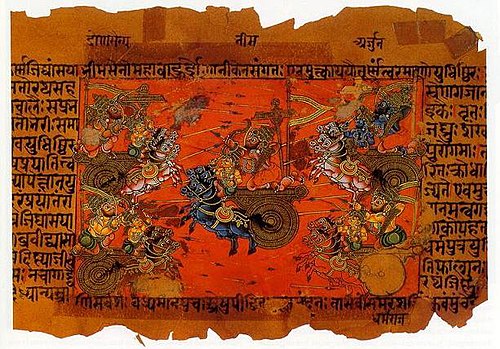Facts for Kids
The Mahabharata is an ancient Indian epic that narrates the great war of Kurukshetra and discusses themes of morality, duty, and the complexities of human nature.
Overview
Philosophical Themes
Characters And Their Roles
Main Events And Plot Summary
Modern Relevance And Influence
Cultural Impact And Adaptations
Interpretations And Commentaries
Historical Context And Significance
Comparative Analysis With Other Epics

Inside this Article
The Bhagavad Gita
Social Structure
The Mahabharata
The Iliad
Community
Kingdom
Culture
Krishna
Nature
Did you know?
📜 The Mahabharata is one of the longest epic poems in the world, comprising over 100,000 shlokas.
🪖 It tells the story of the Kurukshetra War and the fates of the Kaurava and Pandava princes.
🔱 The Bhagavad Gita, a sacred text of Hindu philosophy, is part of the Mahabharata.
👑 The epic encompasses numerous narratives, laws, and morals within its vast chapters.
⚔️ The central theme revolves around dharma, duty, righteousness, and justice.
👥 Notable characters include Arjuna, Krishna, Bhishma, and Draupadi.
🌌 The Mahabharata includes various sub-stories and characters that delve into concepts of fate and free will.
🔥 The text is attributed to the sage Vyasa, who is also a character within the story.
🌿 The Mahabharata presents complex relationships and familial bonds, often leading to tragic consequences.
🕊️ It has been a significant cultural influence in art, literature, and philosophy throughout South Asia and beyond.
Introduction
It is one of the longest poems in the world, with over 100,000 verses! This story centers around two groups of cousins, the Pandavas and the Kauravas, who compete for the throne of Hastinapura, a royal city in northern India. 🏰
It mixes exciting adventures, battles, and lessons about life. The Mahabharata also features the Bhagavad Gita, a sacred dialogue between Prince Arjuna and the god Krishna, sharing important ideas about duty and righteousness!
Philosophical Themes
One key theme is Dharma, or duty. Characters must decide what is right or wrong in difficult situations. For example, Arjuna hesitates to fight his own family but learns from Krishna that sometimes, duty requires hard choices. The story also discusses Karma, the belief that good and bad actions influence our future. 🌪
️ These themes encourage readers to think deeply about their choices and the impact they have on themselves and others.
Characters And Their Roles
👩👧👦 Here are a few key ones:
- Yudhishthira: The oldest Pandava brother, known for his honesty.
- Draupadi: The brave wife of the Pandavas, who faces many challenges. 💪
- Arjuna: A skilled warrior and archer, who learns from Krishna. 🏹
- Krishna: An avatar of the god Vishnu, guiding and helping the Pandavas.
- Dhritarashtra: The blind king, father of the Kauravas, who conflicts with the Pandavas.
Main Events And Plot Summary
️ The story begins with family disputes and grows into a fierce battle for power. First, the Pandavas are exiled, but they return to reclaim their kingdom. 🌄
The war lasts 18 days and sees many heroic fights. After the battle, the Pandavas win but face the sorrow of lost friends and relatives. In the end, Yudhishthira becomes king, but the story teaches about the importance of truth, justice, and the consequences of ambition.
Modern Relevance And Influence
It teaches valuable lessons about ethics, family, and community. In schools, children learn about the epic’s characters and themes, inspiring young minds to think about their choices. The story also appears in popular culture, through movies and books, making it accessible to everyone! 💫
It's a reminder that ancient tales can still help us navigate today's challenges with honor and courage!
Cultural Impact And Adaptations
It inspires dance, theater, and even TV shows. One famous adaptation is the TV series released in 1988, which captivated millions! 🎥
There are also modern versions, such as comics, cartoons, and video games. The epic teaches valuable lessons and is celebrated through festivals like Diwali and Holi, highlighting the victory of good over evil and unity among people!
Interpretations And Commentaries
Commentaries explore its deep meanings and lessons. Some suggest that it teaches about the complexity of human nature, while others view it as a guide to finding inner peace. Different cultures have their own interpretations, making the story relatable to various audiences. For example, modern writers may focus more on themes of gender roles, showing how Draupadi stands strong in the face of adversity! 💃
Historical Context And Significance
️ It reflects historical events and the social structure of the time, including royal families and important customs. The story showcases the significance of family ties and values during challenging times. The battles fought represent not just physical wars, but struggles for righteousness, making it relevant even today! 🌏
The epic is important for understanding Indian history and culture, as it has inspired many generations.
Comparative Analysis With Other Epics
One famous epic is the Iliad from Greece, which also tells the story of a war and heroes. Both epics focus on family conflict, bravery, and complex characters. However, while the Iliad emphasizes heroism and glory, the Mahabharata explores themes of morality and duty. Another epic, the Aeneid from Rome, shares the journey of a hero, but it does not include the same depth of philosophical teachings found in the Mahabharata!

